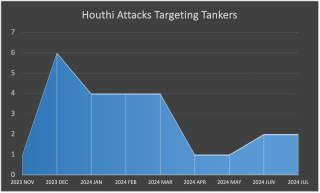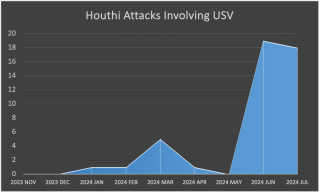
Houthi Attacks on Russia-Linked Tankers

Part of a series: Maritime Spotlight
or see Part 1: Tracking Maritime Attacks in the Middle East Since 2019
Available data suggests the Yemeni group has been going after vessels carrying Russian cargo, particularly if an operator's ships have visited Israeli ports.
On July 15, Yemen’s Houthis used explosive and fuel-laden unmanned surface vessels (USVs) against two passing oil tankers in the southern Red Sea carrying Russian oil to the Asian market. In one of the attacks, the group targeted the Liberia-flagged crude oil tanker Chios Lion (IMO 9398280), which was carrying oil products loaded at Russia’s Tuapse port and heading to China. The attack caused minor hull damage, either because of the angle of attack or because armed security guards onboard managed to fire at the USV and destroy it right before it made impact with the hull.
The Houthis largely spare Chinese- and Russian-owned ships, most likely because they view China and Russia as non-Western powers with which they are willing to engage. Available data suggests, however, that the group has been attacking other vessels carrying Russian cargoes as well as vessels heading to China or even Iran, particularly if the owner/operator has ships that visit Israeli ports. This is part of the Houthi effort to disrupt trade with Israel, which intensified as part of the “fourth phase” of the group’s campaign, and to shape the behavior of the shipping industry when it comes to trading with Israel.
Russian Cargo and USV Trends
During the second attack on July 15, the Houthis targeted the Panama-flagged oil/chemical tanker Bentley I (IMO 9253129) as it sailed in the southern Red Sea with a cargo of vegetable oil loaded in Russia and signaling for China (see tracked voyage below). The group attacked the Bentley I multiple times with a combination of small boats and a USV in addition to four missiles, according to the Joint Maritime Information Center. Despite the intensity of the attack, the vessel was not hit and continued its voyage, but instead of heading to China reached India’s Kandla anchorage on July 22, according to MarineTraffic data.
Data from the Washington Institute’s maritime incident tracker shows that prior to the attacks on the Chios Lion and Bentley I, the Houthis attacked at least three other tankers carrying cargoes loaded in Russia. The crude oil tanker Huang Pu (IMO 9402469), whose name changed in June, was attacked in March, most likely due to past links to Britain. The Panama-flagged crude oil tanker Andromeda Star (IMO 9402471), which is part of the “shadow fleet” transporting Russian oil, was attacked in April, also most likely due to its past UK links. And the Panama-flagged crude oil tanker Wind (IMO 9252967), which also has a record of carrying Russian and Venezuelan oil, was attacked in May for unclear reasons.
Overall, since November 2023, when the Houthis launched their maritime campaign, at least twenty-five oil tankers of different types have been targeted in the southern Red Sea and the Gulf of Aden, according to the Institute’s maritime incident tracker. The Houthis used various types of weapons, including antiship ballistic missiles (ASBMs) and one-way attack drones (OWADs).
In a dramatic escalation, the number of USVs deployed by the Houthis in the southern Red Sea in June jumped to at least nineteen, compared to at least one in April. So far in July, the Houthis have launched at least eighteen USVs. While most of these were destroyed by U.S. Central Command and EU Naval Force ASPIDES, in June the Houthis successfully sank a bulk carrier (Tutor) with a USV for the first time since last November. In the meantime, at least two oil tankers have suffered minor damage due to attacks involving this type of weapon.
The Houthis are no strangers to USVs, which they have been using with varying degrees of sophistication, competence, and effectiveness since January 2017. That year, at the height of the Yemen conflict, the group surprised Saudi Arabia’s navy by attacking one of its frigates using such a weapon. The attacks since November 2023 also demonstrated a significant increase in Houthis’ naval capabilities and in their efforts to disrupt maritime traffic in the Bab al-Mandab Strait, a chokepoint critical to global trade.
The sharp increase in the use of USVs in the past two months suggests that either the Houthi leadership is unsatisfied with the middling results produced by other weapon types, especially when the intention is to sink the targets, or that their missile and drone stockpiles are running low.
Are Tankers with Russian Oil Avoiding the Red Sea?
Tankers transporting Russian crude oil and oil products continue to use the Suez Canal and Red Sea. In fact, Western sanctions on Russia’s oil industry have led to an increase in ships carrying Russian oil that transit the Suez Canal, particularly en route to China and India—Moscow’s key oil customers. Data from the U.S. Energy Information Administration shows that Russian oil exports “accounted for 74% of Suez southbound oil traffic in the first half of 2023, up from 30% in 2021.” Yet due to the Red Sea crisis, not all tankers with Russian cargoes have been sailing through this risky region, with some opting to take the longer route around the Cape of Good Hope.
The day after the attack on the Chios Lion, which is operated by Stealth Maritime Corporation (owned by the Greece-based Vafias family), at least one other tanker linked to the company—which was also carrying cargo loaded in Russia—changed course to avoid the southern Red Sea. The vessel, whose name is being withheld out of concern for the crew’s safety, was traveling from Russia’s Ust-Luga oil terminal and signaling for Egypt’s Port Said, but instead of sailing through the Strait of Gibraltar navigated around southern Africa, signaling for the Indian port of Sikka, according to data from MarineTraffic and Kpler. Another tanker linked to Stealth Maritime, which also carried cargo loaded at Ust-Luga and signaled for Sikka, was supposed to sail through the southern Red Sea, yet as of July 20 it was headed northbound for Egypt’s Ain Sokhna. The tanker may have changed course in response to the Chios Lion attack, which according to the Conflict and Environment Observatory caused a 220-kilometer oil slick (see satellite image below).
For months, the Houthis have been attacking vessels owned or operated by several Greek shipping companies because they call at Israeli ports. While the July 15 attack on the Chios Lion appears to have forced at least one ship linked to Stealth Maritime to avoid the southern Red Sea, other tankers carrying cargoes loaded in Russia continue to transit the region. Vulnerable targets remain vessels with U.S., British, or Israeli links, although in some instances the motives behind the Houthi attacks are unclear.
On May 28, the Houthis attacked the Greek-owned bulk carrier Laax (IMO 9512355) multiple times as it sailed in the southern Red Sea, clearly intending to sink it, even though based on MarineTraffic data, the ship’s final destination was Bandar-e Imam Khomeini in Iran. According to data from MarineTraffic confirmed by TankerTrackers.com, following the attack the damaged ship proceeded to the Persian Gulf and remained at the emirate Sharjah for a few weeks before departing for the Iranian anchorage on July 11, 2024.
Following the July 19 Houthi drone attack on Tel Aviv and Israel’s bombing of the Houthi-controlled Hodeida port in response, the Yemeni group vowed to escalate its campaign against Israel and Western interests in the region. A relative lull in attacks in the Red Sea and Bab al-Mandab could occur, however, if the Houthis decide to focus significant manpower and resources on launching attacks on Israel, with or without the direct involvement of the other members of the “axis of resistance.”
View the maritime attack tracker here.












